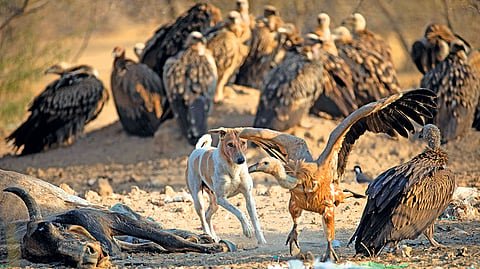

From a place of disposal to a conservation haven, Rajasthan’s Jorbeer has seen an unusual yet natural transformation. Located on the outskirts of Bikaner city, the 56 sq km ground was a regulated site for disposal of animal carcasses. This naturally attracted scavengers, particularly vultures. In 2008, the state government officially named the ground Jorbeer Conservation Reserve to boost populations of vultures and other raptors. Since then, the reserve has served as a regulated vulture feeding site, with nature lovers flocking to spot native and migratory vultures. However, visit the ground now and it will appear overrun by not vultures, but dogs—1,000 in number. Even if a few vultures swoop down to feed on the remains, the dogs chase them away to protect what they deem is now their territory.
Jorbeer, the Keru landfill in Jodhpur district and Bhadariya oran (sacred grove) in Jaisalmer are just some sites in Rajasthan where dogs and vultures inadvertently share a feeding guild. In all the sites, dogs seem to be the dominant scavenger.
This scenario is likely a case of trophic cascade—an ecological phenomenon that describes changes in the natural food chain due to removal of one predator and emergence of another. To put it another way, dogs are increasingly re-placing vultures as dominant scavengers, not just in Rajasthan but across the country.
This shift happened after the 1990s, when the vulture population began to plummet in India because of diclofenac. The non-steroidal anti-inflammatory drug (NSAID) was used on livestock and poisoned vultures that fed on carcasses with traces of the medicine. By 2000, populations of three major species in India—white-rumped vulture (Gyps bengalensis), long-billed vulture (Gyps indicus) and slender-billed vulture (Gyps tenuirostris) —plummeted by almost 98 per cent. The International Union for Conservation of Nature (IUCN) classified them as critically endangered.
This presented an opportunity for dogs, which shared an ecological niche...
This article was originally published in the September 1-15, 2025 print edition of Down To Earth